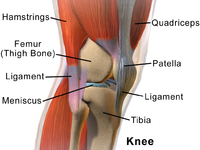
Photo from wikipedia
Background and Objectives: Idiopathic anterior knee pain is a common condition in adolescents and is mostly of unknown cause. The aim of this study was to examine the influence of… Click to show full abstract
Background and Objectives: Idiopathic anterior knee pain is a common condition in adolescents and is mostly of unknown cause. The aim of this study was to examine the influence of the Q-angle and muscle strength on idiopathic anterior knee pain. Materials and Methods: Seventy-one adolescents (41 females and 30 males) diagnosed with anterior knee pain were included in this prospective study. The extensor strength in the knee joint and the Q-angle were monitored. The healthy extremity was used as a control. The Student’s paired sample t-test was applied for testing the difference. Statistical significance was set at 0.05. Results: There was no statistically significant difference in the Q-angle value between the idiopathic AKP and the healthy extremity (p > 0.05) within the entire sample. A statistically significant higher Q-angle of the idiopathic AKP knee (p < 0.05) was obtained in the female subgroup. No statistically significant difference (p > 0.05) was found in the male subgroup. Within the male subgroup, the strength of the extensors within the knee joint of the healthy extremity had statistically significant higher values than the strength of these muscles in the affected extremity (p < 0.05). Conclusion: A greater Q-angle is a risk factor linked to anterior knee pain within the female population. Decreased muscle strength of knee joint extensors is a risk factor linked to anterior knee pain in both sex subgroups.
Journal Title: Medicina
Year Published: 2023
Link to full text (if available)
Share on Social Media: Sign Up to like & get
recommendations!